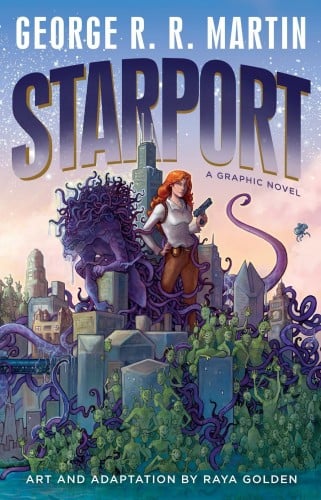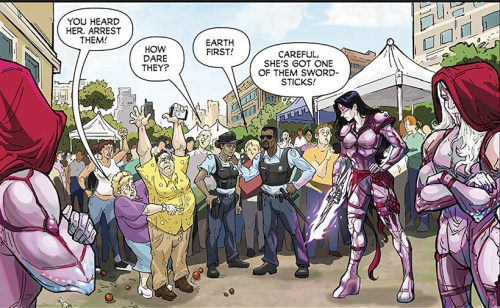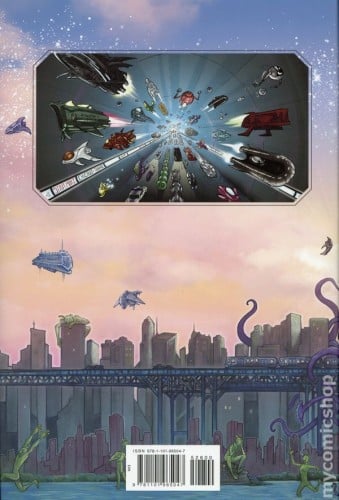Westeros
The 'A Song of Ice and Fire' Domain
News
(Disclosure: Linda and I have known Raya Golden since she she gave us a ride to and from the Chateau Marmont for a party during the 2006 Worldcon in Anaheim. Surviving the inevitable L.A. traffic jam and wondering who that starlet who passed us at the entrance was was a bonding experience never to be forgotten.)
Starport, a massive 272 page graphic novel, is Raya Golden‘s adaptation of George R.R. Martin‘s unproduced pilot script of the same name. Featuring the travails of Chicago’s police force and the many different alien species who come to visit its starport (one of three built on Earth by the league known as the Harmony of Worlds). Martin himself pitched it to studios as “Hill Street Blues meets aliens”, while Golden has suggested more contemporary pairings—“Brooklyn 99 meets Babylon 5... the cast of NYPD Blue on acid, playing laser tag with Alf,” and those are all pretty apt comparisons for the tone of this adaptation. Humor comes first, but as with all of Martin’s work there’s other elements—drama, romance, and even a wee bit of horror.
This is Golden’s second adaptation of Martin’s work, with the first being Meathouse Man, based on a particularly dark novella by Martin. That adaptation led to Golden being nominated for the 2014 Hugo Award, so Starport has big shoes to follow. Her artwork here (helped by colorist Rachel Hilley and letterer Bill Tortolini, another old hand at Martin adaptations with his role in the “Dunk & Egg” comic book adaptations) is clean, bright, and supports the humorous tone of much of the comic. The art style suits the adaptation of Martin’s first draft of the pilot script, which Golden describes as having been more humorous compared to the second draft’s grittier, hard boiled take on the concept.
The cast of notable characters is substantial; by my count, there’s over two dozen characters of note. It’s an expansive cast of characters for a single graphic novel, but then again that first version of the script—which was supposed to be for a 90 minute broadcast—ran nearly 2 hours, per Martin, which in part explains why the graphic novel is so lengthy. You can pick out elements in Starport that Martin has explored in other stories and, including in A Song of Ice and Fire, both in the characters and some of the themes. There’s the name Dahrys Nhar-kql, which seems to have just a little bit of similarity to Daenerys. For that matter, while she has “hair of coal”, others of her race have platinum or pale gold hair and what look suspiciously like violet eyes. The fact that her militant, honor-bound race are called Angels also brings to mind both the Steel Angels cult and the warriors of High Kavalaan of Martin’s “Thousand Worlds” science fiction setting. There are certain character-types as well, like the red-haired police detective admired by an alien who calls her “Hair-Like-Fire”. This intertextuality makes the novel an easy pick up for an aficionado of Martin’s work.
Despite the sheer length of the graphic novel, in general it moves quite briskly. The exception are a handful of places where extensive exposition takes place, two or three characters doing very little beyond explaining to one another how things work for the benefit of readers (at best, the manner in which they speak and the arguments or views they put forward end up providing a little added characterization). But these are rare when looked across the full length of the text. There’s all sorts of referential jokes—many of which Golden has clearly updated to better fit this decade, although there’s a fun one that went over my 40-year-old head until the reveal.
The only real issue I was wrestling with after finishing the novel was that it felt incredibly jam-packed with ideas and characters, but the sheer number means that many of them are treated superficially, barely scratching the surface. On the one hand, this makes all the sense in the world: the original pilot would simply have introduced with broad strokes the world and its characters with the idea that, if intriguing and good enough, it would then get picked up and turned into a series with 22 episodes a season for as many seasons as a network ordered. That would be plenty of time to explore all of these various plot and character threads that Martin laid out.
On the other hand, however, it does mean that it’s hard to feel like one has a deep understanding of the setting and its characters even after having spent 272 pages with them. The sheer scope of it all—and the fact that the number of very alien aliens, spacecraft, etc. would have strained the budgets of most mid-90s TV series—no doubt contributed to why the network passed on producing it (their loss, our gain, of course). Perhaps this aspect of the project is why the ending of the graphic novel leaves a literal question mark as to whether Golden could follow this up with a sequel, either all-original or based on Martin’s input (either contemporaneously or from any bible or story treatments he created as part of the pitch). It would be great if it did happen, and perhaps we’d start getting more of a sense of some of these two dozen characters… but given the vicissitudes of the comics business, it’s nothing one can depend on.
This is not, by any means, a science fiction version of A Song of Ice and Fire (though there’s one particular story thread that wouldn’t feel out of place there). But for me it was charming fun that really threw one back to the syndicated series of decades past. A bit of nostalgia never hurt anyone!
Tags: Starport, Raya Golden, Graphic Novel, George R.R. Martin George R.R. Martin • Other Books and Projects • Licensed Products | PermaLink


